Menus
- The first two-stroke of the Grands Prix 500
- 3-cylinder engine, 498 cm3, 82 hp and 59 Nm, 134 kg dry
- Genesis
- Discovery
- In the saddle
- Test
- Cycle part
- Braking
- Conclusion
The first two-stroke of the Grands Prix 500
3-cylinder engine, 498 cm3, 82 hp and 59 Nm, 134 kg dry
Ironic, really. Of the four Japanese manufacturers, Kawasaki was the only one to definitively turn its back on the two-stroke Grands Prix at the end of 1982 in order to focus the attention of its racing department on the four-strokes sold in homologated version for the road. Yet it is the manufacturer who was responsible for the most important motorcycle in the history of the GP 500 with the H1R. Because this is the Kawasaki H1R which ushered in the modern era of competitive technology by making its international debut and is celebrating a big anniversary this year. Because the 500 three-cylinder two-stroke Kawasaki H1R H1R was born 50 years ago in 1970. Test of a legend.
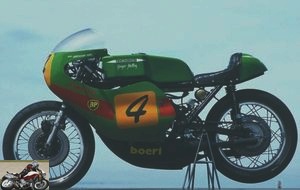 Test drive of the sporty Kawasaki H1R
Test drive of the sporty Kawasaki H1R
Genesis
Honda’s withdrawal from the motorcycle Grands Prix at the end of 1967 had left the 50 and 125 categories under the control of its two-stroke rivals, while the FIM ban on engines with more than two cylinders would do the same for the 250 after Benelli’s title in 1969 with Kel Carruthers. The 350 class was already inundated with Yamaha two-strokes, leaving only the 500 class as the ultimate stronghold of 4-stroke supremacy. But that was only because the Japanese hadn’t yet decided to develop a motorcycle for it. And in 1970 they did.
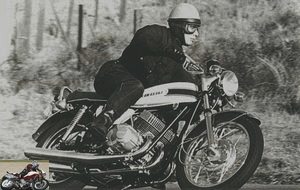 The 1969 Kawasaki H1 Mach III
The 1969 Kawasaki H1 Mach III
Kawasaki had already stunned the world in 1969 with the launch of the modern era’s first large-capacity two-stroke road motorcycle with the H1 Mach III; a simply stunning machine and the first real roadster in history. Inevitably, it quickly found its way onto the circuits after gaining credibility on the streets by immediately showing itself to be competitive and surprisingly reliable, as well as by its impressive speed against the four strokes of the time. It performed well enough to win the 1000 km of Le Mans in 1969 and then narrowly missed out on success at the Bol d’Or by finishing 2nd, 3rd and 4th after giving up the lead of the race to the winning Honda 750 in the last few. time. For a company whose greatest success on the track so far had been winning the GP 125 title with Dave Simmons the same year, this was a short, but inevitable step in developing the GP 500 prototype that the Mach III seemed destined to be. to beget. In doing so, Kawasaki changed the face of Grand Prix forever.
Unless you call yourself Giacomo Agostini and parade by stringing victories and world titles on the MV Agusta, you had to be satisfied to drive a British mono based on the Matchless G50 or Norton Manx if you wanted to race in the 500 class until late 1969. These bikes were at least 60 km / h slower than the MV but had the advantage of being cheaper to run and easier to maintain than the Italian Paton and Linto twins, the only other options for private riders. . You did have the option of driving a supercharged 350 2-stroke, but it was not a viable option. The first 2-stroke to reach a podium in the 500 was Ginger Molloy’s 360 Bultaco who finished 3rd in the Spanish GP 69 at Jarama, but with only seven drivers on the track.
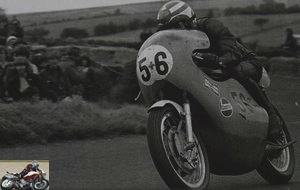 Molloy at the 1971 Ulster GP
Molloy at the 1971 Ulster GP
But a year later, the two-stroke became an option. Molloy, an experienced Continental Circus member who was his own mechanic, knew better than anyone how to prepare a temperamental and crisis-prone 2-stroke sportscar, how to make it reliable and how to ride it properly. He did so by finishing second behind Ago’s MV in the 500 World Championship in the first season of the private Kawasaki H1R..
Discovery
Closely based on the H1 Mach III roadster, the air-cooled 35 H1R sports cars that Kawasaki built use the same detachable crankcase, cylinder and cylinder head castings. The architecture of the 498cc engine included three separately cast air-cooled cylinders, each with a single large intake and exhaust port, mounted transversely in-line to the crankcase and powered by a trio of Mikuni VM35SC carburettors that most of owners upgraded to 36 mm.
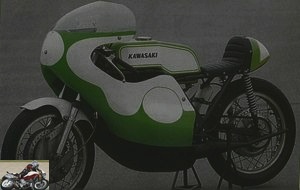 The H1R as delivered by Kawasaki
The H1R as delivered by Kawasaki
Lubrication was provided by the typical Kawasaki injection system fed from an oil reservoir under the seat and mounted on the right end of the crankshaft at 120 degrees. Forged pistons 20 grams lighter than those of the Mach III were mounted on the 60 x 58.8 mm engine whose five-speed gearbox used a dry clutch mounted behind the oil injectors. The Mach III’s electronic ignition was replaced by a battery and three separate coils. But most homeowners, like Molloy, installed a Kr transistorized systemöber which saved weight by getting rid of the battery while avoiding misfires.
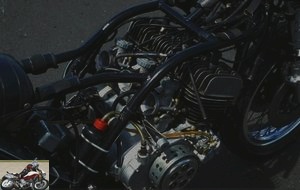 The 498cc 3-cylinder engine
The 498cc 3-cylinder engine
Delivering 75 hp at 9,000 rpm in stock, more than a third more than a Norton Manx or a Seeley G50 which weighed more than the 135 kg dry of the Kawasaki, the big handicap of the H1R was its high fuel consumption with almost 18 l / 100 km. The fuel load needed to satisfy this thirst at the time when FIM rules required that motorcycles had to last at least an hour, was a real penalty. This was true not only in terms of weight and time wasted making pit stops to refuel, but also because a motorcycle already exhibiting compromises in its chassis design doesn’t see its improved handling with 30 liters of fuel on board.
The width of the three-cylinder engine required it to be mounted very high in the Norton Featherbed-inspired frame in order to maintain acceptable ground clearance, even on the meager triangular racing tires of the day. The crankshaft was located 75 mm above the axle center line. Sticking 22 liters of gasoline in the tank and then adding another 8.5 liters in the rear section must have made the Kawasaki very demanding in the first laps of the race or after refueling. Stopping the bike was also a real problem. Because the 280 mm 4-cam drum at the front was insufficient. Most riders installed a lighter and more efficient 250mm Fontana 4-cam drum by 1970. By the following season disc brakes typically sourced from Honda CB 500s and 750s became commonplace..
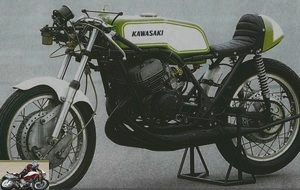 The H1R was originally fitted with front drum brakes.
The H1R was originally fitted with front drum brakes.
50 years after its brilliant season, Ginger Molloy’s motorcycle is still alive and still riding in Australia in its original form thanks to Kevin May’s son who bought the motorcycle from Molloy in 1972. Brendan May used GP’s Kawasaki for racing in historic novice races before running out of pistons and breaking the center cylinder, causing him to put the bike away and switch to a modern Yamaha 250. But the galloping rise of Post-Classic racing in Oceania prompted him to come out of retirement and rehabilitate it. In 1994, the H1R took to the track again for the first time in 8 years, allowing Brendan to win several times at Phillip Island and then in the championship. Finding a vintage motorcycle in such close condition to its origins is something rare. It is here almost identical to the one equipped with the H1R-A kit installed in 1971 and which notably made it possible to push the power up to 80 hp at 9,500 rpm.
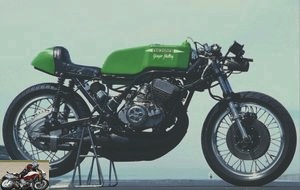 The Molloy H1R, preserved almost identically 50 years later
The Molloy H1R, preserved almost identically 50 years later
In the saddle
The riding position is more reminiscent of a 125 than a 500 with a lean top fairing and heavily lowered handlebars that leave only leverage to take it around corners, but presumably help present a relatively slim profile while still you. making you lie far behind the little bubble.
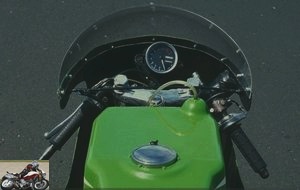 The H1R offers a truly extreme position
The H1R offers a truly extreme position
Aside from the breakage and clutch issues, Brendan assured me that the bike had been very reliable the entire time he rode it, thanks to modern racing pistons and Bel-Ray oil. Still, I couldn’t persuade myself to remove my hand that I was keeping on the clutch lever, just in case. !
Test
Finally, it was when I hadn’t yet decided to no longer hold on to last place that the power suddenly came in full force. Make no mistake, riding this bike requires a skill that I was only able to partially acquire during my test at the Phillip Island circuit..
The first trick is to start it. The action of the clutch is very rigid. So it is quite difficult to get it going and it takes a real skill to match the throttle opening to the revs, which makes stroller starts a real challenge, although practice should help. Once the bike is started – OK I had to ask Brendan to do it – it is also complicated to get him to go. You need more practice Alan !
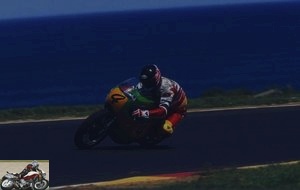 Kawasaki’s clutch is very hard and does not make things easier
Kawasaki’s clutch is very hard and does not make things easier
The problem is that a career of testing modern two-stroke GPs hadn’t prepared me for the degree of brutality it took on the Kawasaki’s clutch to crank up the revs and sing the engine. This is a motorcycle from the days when a clutch lever was your passport to victory, delivering power immediately rather than smoothly.
Already, there is no power below 7,000 rpm and to move it forward you have to run the engine at 8,000 rpm or more. But when the meter hand reaches that mark on the dial, then it is better to hold on tight. The Kawa suddenly rushes forward as the power increases. And if you’re on the corner at this point, for example exiting one of Phillip Island’s slow corners, be prepared for the Avon rear tire to roll over the asphalt in search of grip and your heart rate skyrockets. It is by making this mistake that you learn that it is imperative to straighten the Kawasaki before accelerating hard or changing gear, while trying not to drop the revs below the power band. But since the red zone is at 10,000 and you only have a five-speed gearbox, it’s easier said than done..
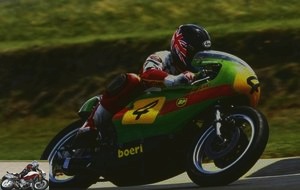 The engine here delivers 80 horsepower at 9,500 rpm
The engine here delivers 80 horsepower at 9,500 rpm
Back in the pits, Brendan gave me some great advice:
"The 10,000 RPM red line is only for the standard H1R while this engine upgraded to less horsepower at low revs, but it sure is a bit higher."
Ok boss, I did. And now I can believe that the incredible speed measured in Bathurst at 276 km / h is true, because a) it thrives better at high revs and changing to 10,500 and above makes it easier to stay above the 8,000 rpm barrier. / min and b) the Kawasaki is extremely fast, not just by 1970 standards. I mean, really. Swapping a Manx for it must have been like flying a Concorde after a turboprop plane. The future was waiting for us and it was called Kawasaki.
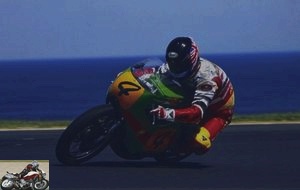 The H1R is really fast and not only by the standards of the time
The H1R is really fast and not only by the standards of the time
Cycle part
The lower part of the fairing is relatively bulbous, but it doesn’t touch easily and the handling is even quite good, in the context of 50 years ago. The high center of gravity makes it awkward in slow turns where it tilts quite suddenly despite the rather open caster angle and the large bulging tank which make it difficult to control..
It goes through bumps, like the one inside Lukey Heigts, like any double-shock motorcycle of the day does. The Kawasaki then seems relatively controllable, at least with the low fuel load I’m riding. The Koni shocks that replace the original Kawa are 10 mm longer. While this corrects the ground clearance problem, understeer does not, which remains a main feature of this bike’s handling. It pushes forward and goes outward when I try to accelerate in the middle of the curve and I then have to make a sustained effort to get it back on track. The fact that the Bridgestone 110 / 80-18 tire was overinflated might not have helped, especially with the rather sensitive fork which was barely on every bump..
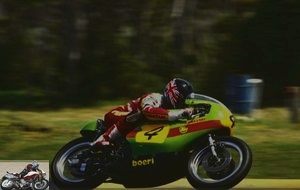 Kawasaki has a tendency to understeer
Kawasaki has a tendency to understeer
Hold on tight and grab that big tank with your elbows and knees while keeping the throttle open, or draw a smoother trajectory and try to keep the bike as straight as possible on a curve, braking hard before picking up. angle, then accelerating to the chord point, as with a racing car. Late braking, early acceleration and short transition are the keys to quickly riding a motorcycle like this.
Braking
Just make sure you brake hard until the last moment with the clutch engaged to go down two or three gears at the same time. Approaching MG or Siberia is a matter of timing and judgment. The Honda CB500 discs that Molloy installed on the bike have little bite like two of my Harley XR750-TT on which I finally installed a Fontana drum. The discs may be lighter than the original Japanese drum, but they don’t allow the bike to stop so well and, according to Brendan, Molloy regretted the change. I know why ! And I confirm.
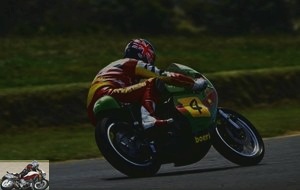 Braking is clearly lacking in power compared to the performance of the bike
Braking is clearly lacking in power compared to the performance of the bike
Conclusion
I’m sure Ginger Molloy didn’t regret riding the Kawasaki to become the man who ushered in the modern era of Grand Prix motorcycle development. Thanks to Brendan and Brad May, this precious piece of motorcycle racing history can still be seen in action today, preserved in its original setting 50 years ago. History comes alive !
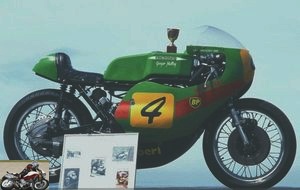 The Kawasaki H1R
The Kawasaki H1R
Strong points
- Powerful
- Maneuverability
Weak points
- Train before
- Braking
- High weight
Kawasaki H1R technical sheet
Related articles
-
Kawasaki Z1B Moriwaki motorcycle test
Wild and brilliant roadster 4 cylinders in line, 1,135 cm3, 119 hp, 160 kg It has been exactly 40 years since New Zealander Graeme Crosby entered the GP…
-
Dick Mann’s motorcycle victorious at the 1971 Daytona 200 The 200 miles of Daytona are one of the legendary races where talented riders on the handlebars…
-
Kawasaki ZZR 1400 motorcycle test
The Very High Speed Motorcycle according to Kawasaki We do three kilometers at 200 then at my signal, we open wide. Sitting next to me, assayer Kawa…
-
Moto Guzzi 500 Bicilindrica sports test
The Methuselah of motorcycle racing 120 ° V-twin, 494 cc, 52 hp, 145 kg Birthday ! Moto Guzzi celebrates its 100th anniversary this year! In contrast to…
-
Kawasaki Z H2 Supercharged motorcycle test
200 hp, 14 mkg at 8,500 rpm, 239 kg all full, 17,099 € Put some salt ! Fifteen days of driving with the Kawasaki Z H2? I say it bluntly, it takes less to…
-
The best-selling of the big roadsters becomes accessible to A2 licenses Four cylinders in line, 948 cm3, 95 hp at 8000 rpm, 91 Nm at 6500 rpm, 210 kilos,…
-
Kawasaki Versys 1000 S Grand tourer motorcycle test
Daily test for fifteen days 1,043 cm3, 120 hp at 9,000 rpm, 102 Nm at 7,500 rpm, 257 kg, 15,099 euros (17,099 euros Grand Tourer version) This bike, to…
-
Offenstadt Kawasaki 750 sports bike test
The H2 Monocoque Pilot-engineers are a rare breed, especially those who are equally expert in both disciplines and able to design innovative and unique…
-
Sports test Ducati 750SS Moreparts
The Desmo of Mike Hailwood’s comeback 90 ° desmo V-Twin, 749 cm3, 73 hp, 180 kg dry Most road racing enthusiasts will tell you that Mike Hailwood did not…
-
The European Grand Prix prototype 108 ° V4, 499 cc, 192 hp at 12,500 rpm, 129 kg We find it normal to see Ducati, KTM and Aprilia currently competing in…
Thank you Alan for this uplifting essay !